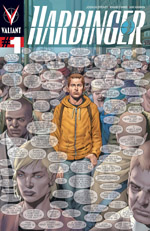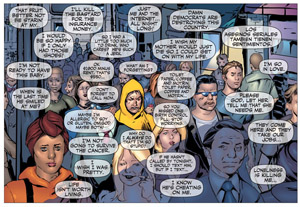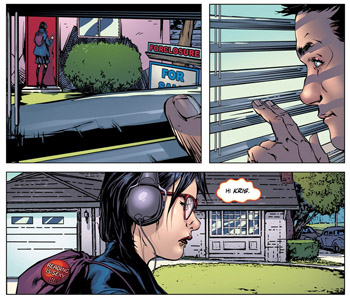 Written by Joshua Dysart
Written by Joshua Dysart
Art by Khari Evans
32 pages, color
Published by Valiant Entertainment
When the original Valiant Comics published Harbinger back in the early ’90s, it was a title I found myself uninterested in right off the bat. The characters seemed a little too nasty and horrible to one another, and while I’m not against the idea of a less-than-admirable protagonist, it had felt a little too rough. It was one of the biggest hits for the company, though, and with the new Valiant Entertainment re-launching some of the original properties, it seemed like a good chance to see how the new version of Harbinger was shaping up. What I found was a book that deliberately doesn’t make things easy for readers.
Joshua Dysart introduces us to the two most important characters from the original Harbinger in the re-launch; Toyo Harada, a brilliant psychic who survived a massacre in his native Tibet some 60 years ago, and Peter Stanchek, an 18-year old boy who us unable to control his own powers in the present day.  Dysart initially gives us some sympathy for Stanchek; he and letterer Rob Steen show us just what it’s like to have telepathic powers that are running rampant, with Stanchek walking though a virtual cloud of thought balloons, blocking the rest of the world through their constant babble. It’s an effective technique to bring across the idea of Stanchek’s powers in a visual manner, and it saves us a lot of exposition. Then, the reader turns the page, and we discover that Stanchek’s using his powers to force pharmacy clerks to give him drugs to dampen his powers, as well as whatever money’s in the cash register, and that sympathy that we’ve built up in just a single page starts to erode.
Dysart initially gives us some sympathy for Stanchek; he and letterer Rob Steen show us just what it’s like to have telepathic powers that are running rampant, with Stanchek walking though a virtual cloud of thought balloons, blocking the rest of the world through their constant babble. It’s an effective technique to bring across the idea of Stanchek’s powers in a visual manner, and it saves us a lot of exposition. Then, the reader turns the page, and we discover that Stanchek’s using his powers to force pharmacy clerks to give him drugs to dampen his powers, as well as whatever money’s in the cash register, and that sympathy that we’ve built up in just a single page starts to erode.
That, at its core, is the struggle of Harbinger #1. One minute you pity a character, the next minute you want to throttle him. Stanchek’s a character who is difficult to like; his life is out of control, but more importantly every time he’s got multiple options he seems to instantly gravitate towards the worse one. Some things are at least minor, like stealing money or drugs. Others, like his using his telepathic powers to have a childhood crush "fall in love" with and sleep with him, are downright horrendous. It’s a nasty, unflinching look from Dysart on what a typical 18-year old with immense powers could be like. The big question, of course, is where Dysart takes Stanchek from here; the rest of the plot, with two rival organizations each fighting for control of Stanchek, feels almost secondary. And while Harada was a villain in the original Harbinger, I found myself appreciating that here we’re at least initially getting a different view of the character. His recognition of every bad thing Stanchek’s done makes him much more likable to the reader (if not to Stanchek), and it makes me wonder if Dysart is holding another reveal under his sleeve. For now, though, Harada is the reverse of Stanchek; calm, collected, controlled, and successful. It’s everything the disastrous Stanchek wishes he was but is about as far away as you can imagine. I like the distance between the two, and want to see more interactions between the pair.
 Khari Evans’ art for Harbinger #1 is all over the place. Sometimes his faces look strong and expressive, but other times they seem unusually twisted or misshapen. The second panel with Stanchek, for instance, makes him look like he has a mustache, but it turns out it’s just a wrinkled upper lip. There’s also what appears to be some reusing of figures and images via computer that is a little too blatant; the two panels at the top of page 5, for example, or the sea of Chinese militants on page 2. Even a few small tweaks here and there would be a big difference, not jumping out as so blatantly reusing art. Still, there are things I like about Evans’ art. I appreciate that Kris is drawn not as a drop-dead gorgeous model, but as that girl who lives next door. She’s attractive, but in a much more realistic manner. Stanchek’s friend Joe also looks ragged and unkempt, a look that we don’t get often in comic book characters. Ultimately I think there’s room for improvement, but there enough here that I’m appreciating what Evans does bring to the book well.
Khari Evans’ art for Harbinger #1 is all over the place. Sometimes his faces look strong and expressive, but other times they seem unusually twisted or misshapen. The second panel with Stanchek, for instance, makes him look like he has a mustache, but it turns out it’s just a wrinkled upper lip. There’s also what appears to be some reusing of figures and images via computer that is a little too blatant; the two panels at the top of page 5, for example, or the sea of Chinese militants on page 2. Even a few small tweaks here and there would be a big difference, not jumping out as so blatantly reusing art. Still, there are things I like about Evans’ art. I appreciate that Kris is drawn not as a drop-dead gorgeous model, but as that girl who lives next door. She’s attractive, but in a much more realistic manner. Stanchek’s friend Joe also looks ragged and unkempt, a look that we don’t get often in comic book characters. Ultimately I think there’s room for improvement, but there enough here that I’m appreciating what Evans does bring to the book well.
Harbinger #1 is a book that is a little nasty and hard to read in places, but it’s also deliberately designed to be that way. I’m definitely going to read a second issue, though; Dysart and Evans have created a book that can literally go in any sort of direction from here. If Harbinger turns into nothing but Stanchek being nasty to people, it might be too much all over again. But for now, I’m intrigued enough that I’m willing to be patient. So far, so good.

One Reply to “Harbinger #1”
Comments are closed.